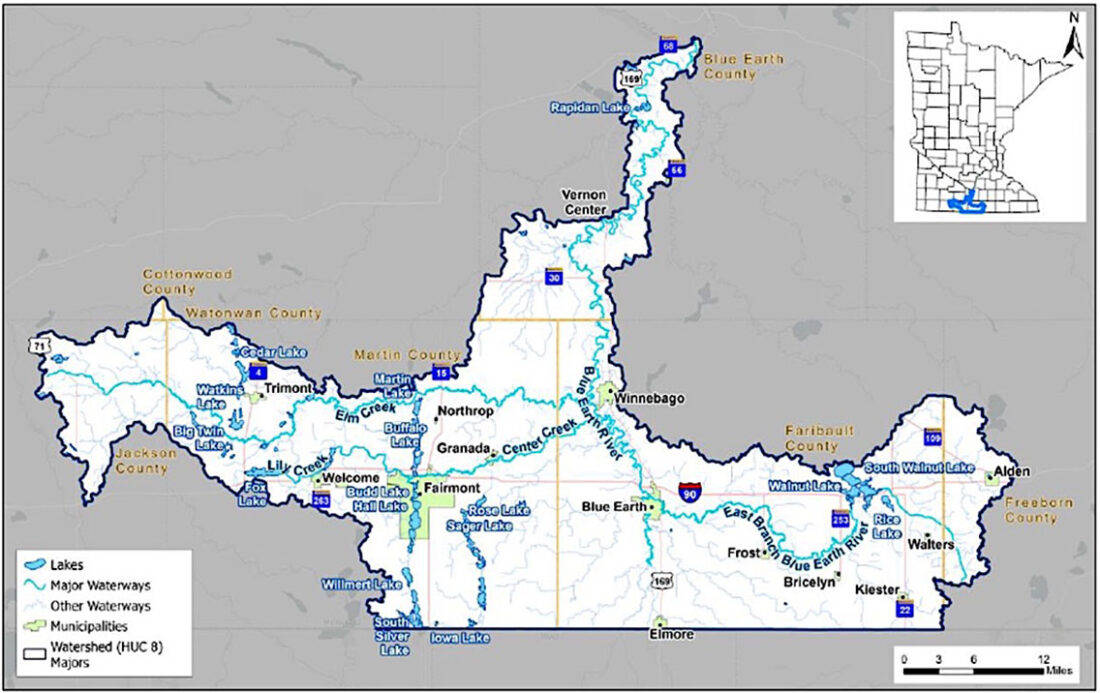Counties solidifying watershed plan

ABOVE: This map charts the Blue Earth River being analyzed and discussed for a Watershed Plan, bridging the goals and grant funding requests of several counties, including Martin.
Fairmont – A watershed plan for the Blue Earth River to unite funding goals through Martin, Jackson, Fairbault, Freeborn and Blue Earth counties has made significant headway with citizen feedback.
Martin County Soil and Water Conservation District (SWCD) Outreach Coordinator Jesse Walters said before this, there used to be competition for the same grants over the same flow of water.
“We wrote a county water management plan,” he said. “You would cite that when applying for grants, say, through the clean water fund. Each county wrote their own water plan, and then each county would write their own grant applications in competition with one another on different grant sources.”
With each county writing its own plans for the same river, Walters said concerns started popping up.
“The water doesn’t stop at a jurisdictional boundary,” he said. “I write my plan and work within my boundary, but the water flows right into the next county where they’re writing their own plan.”
The decision was then made to break these into three sub-watersheds, with the Blue Earth River watershed being one of them. The Des Moines River and Watonwan River Watershed Management plans have already been completed, with the Blue Earth River being the last one to be completed.
“That was somewhat by design,” Walters said. “We have to have the science to inform the plan, and the science wasn’t done yet. The science that I guess I’d be referring to is the Pollution Control Agency is on a 10-year cycle where they do a watershed restoration and protection strategy report. That is preceded by water sampling. They analyze the data, then PCA gives you this full restoration protection strategy for your watershed.”
This information was completed in the last few years, allowing the project to move forward with the latest data. The project has already gone through several phases, including citizen feedback.
“We had a kickoff meeting (May 2024) where the goal was to inform people on what this process looks like and take comments,” Walters said. “It was well attended and advertised, we had a lot of people show up. We did an online survey and an in-person survey, and had a lot of responses on that. People that wanted to be even more involved, there was a citizen advisory committee that we have people serving on.”
Problems to be addressed by the plan include nutrients, sediment and water quantity issues. Excess nutrients mean fertilizers coming from anything from lawns to farms. With water quantity issues, Walters said we get more rain in less time, meaning it gets into creeks, drainage ditches, and rivers, creating potential erosion issues.
Walters said they are prioritizing issues that are funded under specific grants, meaning issues that already receive state funding will be lower since the problem is already worked on with other funding sources.
“It’s a plan we’re writing to guide our prioritization and targeting for the funding through the plan,” he said. “I know a lot of people are going to jump out and say, ‘Aquatic invasive species. We should be spending more of the plan money on that.’ But that’d be somewhat uninformed based on what we’re doing with the plan, because there’s already funding for that we get from the state.”
Practices looked at for funding in the plan can include cover crops, no-till and strip-till, wetland restorations, saturated buffers and water and sediment control basins. When costs for programs are prohibitive, such as tillage changes for farmers, Walters said there will be funding to compensate for doing them.
“There’s going to be farmers that want to do a project, but it’d be really expensive without any cost share,” he said. “Now they might be able to do this project with the help of cost share. A lot of the cost share for these plans, the [program] pays about 75 percent of the project cost. You had a $100,000 project, but if the landowner only has to come up with $25,000, that makes projects a lot more feasible.”
Currently, the plan is going through a 60-day review, where select officials are sent the plan, and comments are sent to the plan architects for review.
For more information, call 507-235-6680 or email Jesse Walters at jesse.martinswcd@gmail.com.




